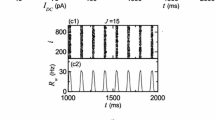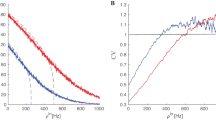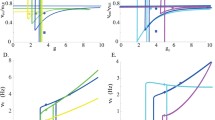Abstract
Synchronization of excitable cells coupled by reciprocal inhibition is a topic of significant interest due to the important role that inhibitory synaptic interaction plays in the generation and regulation of coherent rhythmic activity in a variety of neural systems. While recent work revealed the synchronizing influence of inhibitory coupling on the dynamics of many networks, it is known that strong coupling can destabilize phase-locked firing. Here we examine the loss of synchrony caused by an increase in inhibitory coupling in networks of type-I Morris–Lecar model oscillators, which is characterized by a period-doubling cascade and leads to mode-locked states with alternation in the firing order of the two cells, as reported recently by Maran and Canavier (J Comput Nerosci, 2008) for a network of Wang-Buzsáki model neurons. Although alternating-order firing has been previously reported as a near-synchronous state, we show that the stable phase difference between the spikes of the two Morris–Lecar cells can constitute as much as 70% of the unperturbed oscillation period. Further, we examine the generality of this phenomenon for a class of type-I oscillators that are close to their excitation thresholds, and provide an intuitive geometric description of such “leap-frog” dynamics. In the Morris–Lecar model network, the alternation in the firing order arises under the condition of fast closing of K + channels at hyperpolarized potentials, which leads to slow dynamics of membrane potential upon synaptic inhibition, allowing the presynaptic cell to advance past the postsynaptic cell in each cycle of the oscillation. Further, we show that non-zero synaptic decay time is crucial for the existence of leap-frog firing in networks of phase oscillators. However, we demonstrate that leap-frog spiking can also be obtained in pulse-coupled inhibitory networks of one-dimensional oscillators with a multi-branched phase domain, for instance in a network of quadratic integrate-and-fire model cells. Finally, for the case of a homogeneous network, we establish quantitative conditions on the phase resetting properties of each cell necessary for stable alternating-order spiking, complementing the analysis of Goel and Ermentrout (Physica D 163:191–216, 2002) of the order-preserving phase transition map.














Similar content being viewed by others
References
Acker, C. D., Kopell, N., & White, J. A. (2003). Synchronization of strongly coupled excitatory neurons: Relating network behavior to biophysics. Journal Comparative Neuroscience, 15, 71–90.
Bose, A., Kopell, N., & Terman, D. (2000). Almost synchronous solutions for pairs of neurons coupled by excitation. Physica D, 140, 69–94.
Bressloff, P. C., & Coombes, S. (1998). Desynchronization, mode locking, and bursting in strongly coupled integrate-and-fire oscillators. Physical Review Letters, 81, 2168–2171.
Bressloff, P. C., & Coombes, S. (2000). Dynamics of strongly-coupled spiking neurons. Neural Computation, 12, 91–129.
Brown, E., Moehlis, J., & Holmes, P. (2004). On the phase reduction and response dynamics of neural oscillator populations. Neural Computation, 16, 673–715.
Canavier, C. C., Baxter, D. A., Clark, J. W., & Byrne, J. H. (1999). Control of multistability in ring circuits of oscillators. Biological Cybernetics, 80, 87–102.
Ermentrout, G. B. (1996). Type I membranes, phase resetting curves, and synchrony. Neural Computation, 8, 979–1001.
Ermentrout, G. B., & Kopell, N. (1984). Frequency plateaus in a chain of weakly coupled oscillators. SIAM Journal on Mathematical Analysis, 15, 215–237.
Ermentrout, G. B., & Kopell, N. (1990). Oscillator death in systems of coupled neural oscillators. SIAM Journal on Applied Mathematics, 50, 125–146.
Ermentrout, G. B., & Kopell, N. (1991). Multiple pulse interactions and averaging in systems of coupled neural oscillators. Journal of Mathematical Biology, 29, 195–217.
Glass, L., Guevara, M. R., Belair, J., & Shrier, A. (1984). Global bifurcations of a periodically forced biological oscillator. Physical Review, A 29, 1348–1357.
Goel, P., & Ermentrout, G. B. (2002). Synchrony, stability, and firing patterns in pulse-coupled oscillators. Physica D, 163, 191–216.
Golubitsky, M., Stewart, I., Buono, P. L., & Collins, J. J. (1999). Symmetry in locomotor central pattern generators and animal gaits. Nature, 401, 693–695.
Golubitsky, M., Josic, K., & Shea-Brown, E. (2006). Winding numbers and average frequencies in phase oscillator networks. Journal of Nonlinear Science, 16, 201–231.
Hansel, D., Mato, G., & Meunier, C. (1995). Synchrony in excitatory neural networks. Neural Computation, 7, 307–337.
Hoppensteadt, F. C., & Izhikevich, E. M. (1997). Weakly connected neural networks. New York: Springer.
Izhikevich, E. M. (2000). Phase equations for relaxation oscillators. SIAM Journal on Applied Mathematics, 60, 1789–1805.
Izhikevich, E. M. (2006). Dynamics systems in neuroscience: The geometry of excitability and bursting. Chapter 10: Synchronization. Cambridge: MIT.
Izhikevich, E. M., & Kuramoto, Y. (2006). Weakly coupled oscillators. Encyclopedia of Mathematical Physics, Elsevier, 5, 448.
Jones, S. R., Pinto, D., Kaper, T., & Kopell, N. (2000). Alpha-frequency rhythms desynchronize over long cortical distances: A modelling study. Journal Computational Neuroscience, 9, 271–291.
Kopell, N. (1988). Toward a theory of modeling central pattern generators. In A. H. Cohen, S. Rossignol, & S. Grillner (Eds.), Neural control of rhythms. New York: Wiley.
Kopell, N., Ermentrout, G. B., Whittington, M., & Traub, R. D. (2000). Gamma rhythms and beta rhythms have different synchronization properties. Proceedings of the National Academy of Sciences of United States America, 97, 1867–1872.
Kopell, N., & Ermentrout, G. B. (2002). Mechanisms of phase-locking and frequency control in pairs of coupled neural oscillators. In B. Fiedler (Ed.), Handbook on Dynamical Systems: Toward Applications. New York: Elsevier.
Kuramoto, Y. (1984). Chemical oscillations, waves, and turbulence. Berlin: Springer.
Maran, S. K., & Canavier, C. C. (2008). Using phase resetting to predict 1:1 and 2:2 locking in two neuron networks in which firing order is not always preserved. Journal of Computational Neroscience, 24, 37–55.
Mirollo, R. E., & Strogatz, S. H. (1990). Synchronization of pulse-coupled biological oscillators. SIAM Journal of Applied Mathemaics, 50, 1645–1662.
Morris, C., & Lecar, H. (1981). Voltage oscillations in the barnacle giant muscle fiber. Biophysical Journal, 35, 193–213.
Netoff, T. I., Banks, M. I., Dorval, A. D., Acker, C. D., Haas, J. S., Kopell, N., et al. (2005). Synchronization in hybrid neuronal networks of the hippocampal formation. Journal of Neurophysiology, 93, 1197–1208.
Oprisan, S. A., & Canavier, C. C. (2001). Stability analysis of rings of pulse-coupled oscillators: The effect of phase resetting in the second cycle after the pulse is important at synchrony and for long pulses. Journal of Difference. Equations and Dynamical Systems, 9, 243–258.
Oprisan, S. A., & Canavier, C. C. (2002). The influence of limit cycle topology on the phase resetting curve. Neural Computation, 14, 1027–1057.
Oprisan, S. A., Prinz, A. A., & Canavier, C. C. (2004). Phase resetting and phase locking in hybrid circuits of one model and one biological neuron. Biophysical Journal, 87, 2283–2298.
Peskin, C. S. (1975). Mathematical aspects of heart physiology. New York: New York University Courant Institute of Mathematical Sciences.
Rinzel, J., & Ermentrout, B. (1998). Analysis of neural excitability and oscillations. In C. Koch & I. Segev (Eds.), Methods in neuronal modeling: From ions to networks (2nd edn). Cambridge: MIT.
Rubin, J., & Terman, D. (2000). Geometric analysis of population rhythms in synaptically coupled neuronal networks. Neural Computation, 12, 597–645
Sato, Y. D., & Shiino, M. (2007). Generalization of coupled spiking models and effects of the width of an action potential on synchronization phenomena. Physical Review E, 75, 011909.
Somers, D., & Kopell, N. (1993). Rapid synchronization through fast threshold modulation. Biological Cybernetics, 68, 393–407.
van Vreeswijk, C., Abbott, L. F., & Ermentrout, B. (1994). When inhibition not excitation synchronizes neural firing. Journal of Computational Neuroscience, 1, 313–321.
Wang, X. J., Buzsáki, G. (1996). Gamma oscillation by synaptic inhibition in a hippocampal interneuronal network model. Journal of Neuroscience, 16, 6402–6413.
White, J. A., Chow, C. C., Ritt, J., Soto-Trevino, C., & Kopell, N. (1998). Dynamics in heterogeneous, mutually inhibited neurons. Journal of Computational Neuroscience, 5, 5–16.
Winfree, A. T. (2001). The geometry of biological time (2nd edn). New York: Springer.
Acknowledgements
This work was supported by the National Science Foundation grant DMS-0417416. We wish to thank Amitabha Bose and Farzan Nadim for helpful comments and discussions.
Author information
Authors and Affiliations
Corresponding author
Additional information
Action Editor: Frances K. Skinner
Electronic supplementary material
Below is the link to the electronic supplementary material.
Appendix
Appendix
1.1 Derivation of the alternating-order phase map with second-order phase resetting
We will use the diagram in Fig. 7(a) to derive the map in the case of non-negligible second-order phase resetting, Δ2(ϕ). Let {ϕ n , ξ n } denote the two phases of the postsynaptic cell at the time of arrival of each of the two spikes in n-th period of the oscillation. In the case of zero second-order resetting, Fig. 7 illustrates the relationship between these phases, ξ n = 1 + ϕ n − Δ(ϕ n ). However, due to non-zero second-order phase resetting received by the presynaptic cell in the preceding cycle, Δ2(ξ n − 1) (where ξ n − 1 is its phase at the time of arrival of the first black spike in Fig. 7(a)), the interval between two spikes of the presynaptic cell in the current cycle, denoted γ n , will not be equal to 1:
Therefore, the modified relationship between ξ n and ϕ n reads
Note that we neglect the much smaller second-order phase-resetting due to the first spike of the presynaptic cell in each period of the 2:2 mode: Δ2(ϕ n ) < < Δ2(ξ n ). Finally, given the phase ξ n of the postsynaptic cell right before receiving its second input, one can easily find its first passage time, ϕ n + 1 (i.e. interval ϕ 2 in Fig. 7(a)), using the first passage time condition
Solving this system of equations for ξ n yields the map
which can be re-written in a more compact form as
If we substitute the conditions for synchronous firing, ξ n = 1, ϕ n = 0, we obtain Δ2(1) = Δ(0), which is the correct periodicity condition relating the first- and second-order STRC curves. Therefore, the synchronous solution is always a fixed point of Eq. (19).
Differentiating Eq. (20) yields the stability condition
which agrees with Eq. (11) when Δ2(·)=0. Close to the bifurcation from synchrony to leap-frog spiking, ξ ≈ 1, Δ′(ξ) ≈ 0, and therefore
which yields
Recall that ϕ = 1 − ξ + Δ(ξ) (Eq. (18)). A more general stability condition for the case of non-negligible Δ2(ϕ n ) is given by Maran and Canavier (2008).
Rights and permissions
About this article
Cite this article
Oh, M., Matveev, V. Loss of phase-locking in non-weakly coupled inhibitory networks of type-I model neurons. J Comput Neurosci 26, 303–320 (2009). https://doi.org/10.1007/s10827-008-0112-8
Received:
Revised:
Accepted:
Published:
Issue Date:
DOI: https://doi.org/10.1007/s10827-008-0112-8




